 |
|
Lesson 6 |
|||||||||||||||||||||||||||||||||||||||||||||||||||||||||||||||||||||||||||||||||||
|
In this lesson we will look at the tie, building a D major scale and the key of D. Plus we will discuss sus4 chords and learn how to play Tom Petty's Free Falling and we will review our open chord with the verse of Greenday's Blvd. of Broken Dreams. Review Lesson 5 |
|
||||||||||||||||||||||||||||||||||||||||||||||||||||||||||||||||||||||||||||||||||
|
|
|||||||||||||||||||||||||||||||||||||||||||||||||||||||||||||||||||||||||||||||||||
| The Tie | |||||||||||||||||||||||||||||||||||||||||||||||||||||||||||||||||||||||||||||||||||
| The tie is used to connect two notes of the same pitch indicating they are to be played as one. |
 |
||||||||||||||||||||||||||||||||||||||||||||||||||||||||||||||||||||||||||||||||||
| The quarter note A tied across the bar line to another A would be treated like a half note. Do not pick the second A. Let it ring. | |||||||||||||||||||||||||||||||||||||||||||||||||||||||||||||||||||||||||||||||||||
| The tie can also be used to connect two notes in the same measure. |
 |
||||||||||||||||||||||||||||||||||||||||||||||||||||||||||||||||||||||||||||||||||
|
|
|||||||||||||||||||||||||||||||||||||||||||||||||||||||||||||||||||||||||||||||||||
| Scales - D Major | |||||||||||||||||||||||||||||||||||||||||||||||||||||||||||||||||||||||||||||||||||
|
To build a D major scale we start on D and follow the
formula: |
 |
||||||||||||||||||||||||||||||||||||||||||||||||||||||||||||||||||||||||||||||||||
|
By building the scale we learn the key of D major has 2 sharps (F# and C#). From what we learned in lesson 5, could you figure out what D majors relative minor would be? The answer is below. The key signature comes after the clef sign and before the time signature. The key signature below means all the F and C's in the music will be played as F# and C#. There is no accidental needed in front of the notes like the D major scale above. |
|||||||||||||||||||||||||||||||||||||||||||||||||||||||||||||||||||||||||||||||||||
 |
|||||||||||||||||||||||||||||||||||||||||||||||||||||||||||||||||||||||||||||||||||
 |
|||||||||||||||||||||||||||||||||||||||||||||||||||||||||||||||||||||||||||||||||||
| D Major in 2nd Position | |||||||||||||||||||||||||||||||||||||||||||||||||||||||||||||||||||||||||||||||||||
|
To build a D major scale in 2nd position we would need to put our fingers in 2nd position. 1st finger on the 2nd fret, 2nd finger on the 3rd fret and so on. Next we need to find a D, which would be the 5th fret of your A string (5th string). So we will start the scale on D with our 4th (little) finger. |
|||||||||||||||||||||||||||||||||||||||||||||||||||||||||||||||||||||||||||||||||||
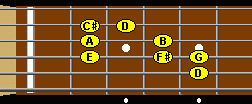 |
|||||||||||||||||||||||||||||||||||||||||||||||||||||||||||||||||||||||||||||||||||
| The scale form above and to the right should look familiar to you. If you moved the form back one whole step it would be C major scale in 1st (also known as open position) that we learned in lesson 2. | |||||||||||||||||||||||||||||||||||||||||||||||||||||||||||||||||||||||||||||||||||
| To the right is a D major scale up and back down with quarter notes and eighth notes. You should try to pick it down down up. You can think about it as long short short. It is the same as the strum pattern from lesson 5. |
|
||||||||||||||||||||||||||||||||||||||||||||||||||||||||||||||||||||||||||||||||||
|
The first track on the player is an ascending D major scale played as quarter notes at 60 bpm (beats per minute). You should practice it descending also. Track two is the above exercise played at 60 bpm. Listen midi file for slower connections or use with midi sequencer. Right click to save as or open in new window. |
|||||||||||||||||||||||||||||||||||||||||||||||||||||||||||||||||||||||||||||||||||
|
B Minor Scale Let's figure out D majors relative minor. Either go down 3 half steps from D or go to the 6th degree of the D major scale and both will give you B. So B minor would be the relative minor of D major. In other words, play your D scale from B to B and you are playing B minor. |
|||||||||||||||||||||||||||||||||||||||||||||||||||||||||||||||||||||||||||||||||||
|
D E F# G A B C# D B minor scale B C# D E F# G A B
And like the scales the key of D major and B minor both have the same two sharps (F# and C#) |
|
||||||||||||||||||||||||||||||||||||||||||||||||||||||||||||||||||||||||||||||||||
|
Diatonic Triads in the key of D major
And just like the scales and keys, the chords in the key of D major and B minor are the same. However, Bm would be called the i chord and C#dim the iidim and D the III and so on. We will explore this in more detail in a later lesson.
|
|||||||||||||||||||||||||||||||||||||||||||||||||||||||||||||||||||||||||||||||||||
|
|
|||||||||||||||||||||||||||||||||||||||||||||||||||||||||||||||||||||||||||||||||||
|
|||||||||||||||||||||||||||||||||||||||||||||||||||||||||||||||||||||||||||||||||||
|
|
|||||||||||||||||||||||||||||||||||||||||||||||||||||||||||||||||||||||||||||||||||
|
D Chord We will build a D chord by stacking the 1st , 3rd and 5th note of the D major scale giving us D, F# and A. |
|||||||||||||||||||||||||||||||||||||||||||||||||||||||||||||||||||||||||||||||||||
 |
|||||||||||||||||||||||||||||||||||||||||||||||||||||||||||||||||||||||||||||||||||
|
To play the chord in root position (as shown above) we would have to play the D on the 5th fret of our A string and F# on the 4th fret of our D string and then A on the 2nd fret of our G string. But just as long as we hear a D, F# and A, it is a D major chord. The notes can be in any order and we can have more than one of any. Below is a popular open D chord: |
|||||||||||||||||||||||||||||||||||||||||||||||||||||||||||||||||||||||||||||||||||
 |
Do not play the 5th or 6th
string. Even though the 5th string is an A and the 5th of a D chord, we
want the root (in this case D) to be the lowest tone.
If we play A in the bass it should be written as D/A Meaning it is a D chord, with A in the bass. More on slash chords in lesson 10. |
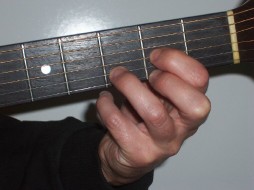 |
|||||||||||||||||||||||||||||||||||||||||||||||||||||||||||||||||||||||||||||||||
|
|
|||||||||||||||||||||||||||||||||||||||||||||||||||||||||||||||||||||||||||||||||||
|
Dsus4 Sus4 chords are chords where we replace the 3rd with the 4th. We build the sus4 chord by taking the 1st, 4th and 5th notes from a major scale. So above we took the 1st, 3rd and 5th from a D scale and that gave us D, F# and A, making a D major chord. For a Dsus4 we will take the 1st, 4th and 5th from the D major scale and get D, G and A. |
|||||||||||||||||||||||||||||||||||||||||||||||||||||||||||||||||||||||||||||||||||
 |
We will leave our 2nd finger on the F# when we play the G with our little finger. The F# will not sound. | 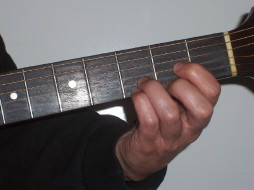 |
|||||||||||||||||||||||||||||||||||||||||||||||||||||||||||||||||||||||||||||||||
|
|
|||||||||||||||||||||||||||||||||||||||||||||||||||||||||||||||||||||||||||||||||||
| A Chord | |||||||||||||||||||||||||||||||||||||||||||||||||||||||||||||||||||||||||||||||||||
|
You should know the A major chord from lesson 1. We can build an A major chord from the 5th note of the D scale or we can build it with the 1st, 3rd and 5th from an A major scale. Either way you will end up with A C# E |
 |
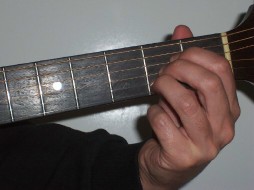 |
|||||||||||||||||||||||||||||||||||||||||||||||||||||||||||||||||||||||||||||||||
|
|
|||||||||||||||||||||||||||||||||||||||||||||||||||||||||||||||||||||||||||||||||||
| Asus4 | |||||||||||||||||||||||||||||||||||||||||||||||||||||||||||||||||||||||||||||||||||
|
So to make our A chord an Asus4, we raise the 3rd (C#) one half step higher (D). Sometimes we will use our little finger to play the D and leave our 3rd finger on the C# but for the Tom Petty song we are about to learn we will use this form with our 3rd finger playing the D. |
 |
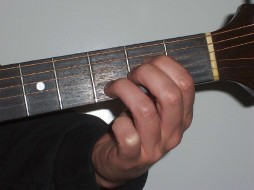 |
|||||||||||||||||||||||||||||||||||||||||||||||||||||||||||||||||||||||||||||||||
|
|
|||||||||||||||||||||||||||||||||||||||||||||||||||||||||||||||||||||||||||||||||||
|
Tom Petty - Free Falling This is a fun and easy tune to play and solo over. It uses the D, Dsus4 and Asus4 chord. The link below will take you back to the free section for the breakdown and also a little more on sus4 chords. |
|||||||||||||||||||||||||||||||||||||||||||||||||||||||||||||||||||||||||||||||||||
|
|
|||||||||||||||||||||||||||||||||||||||||||||||||||||||||||||||||||||||||||||||||||
|
Improvising The Tom Petty tune above is really fun to solo over. Try using your D major scale and take out the 4th and 7th to make it D major pentatonic. Like in lesson 3 you should try and play just one note at a time and let your ears hear the different scale tones over the different chords. Another fun thing to play over this tune is the D major arpeggio from earlier in this lesson.
|
 |
||||||||||||||||||||||||||||||||||||||||||||||||||||||||||||||||||||||||||||||||||
|
|
|||||||||||||||||||||||||||||||||||||||||||||||||||||||||||||||||||||||||||||||||||
|
Blvd. of Broken Dreams - verse The progression below is another popular chord progression and is the one Greenday uses for the verse of Blvd. of Broken Dreams. Even though it starts on an E minor chord, it is not in the key of E minor. The A chord is the giveaway. If we remember from lesson 5, the key of E minor (or it's relative major G) doesn't have an A major chord. It was A minor. However if we look at the chords from the key of D major/B minor we find all 4 chords below belong. So the verse of Blvd. of Broken Dreams is in the key of D major. On the recording it is a half step higher in the key of Eb and a capo is used on the 1st fret making the first chord F minor. We will not worry about the capo right now. |
|||||||||||||||||||||||||||||||||||||||||||||||||||||||||||||||||||||||||||||||||||
 |
|||||||||||||||||||||||||||||||||||||||||||||||||||||||||||||||||||||||||||||||||||
|
|||||||||||||||||||||||||||||||||||||||||||||||||||||||||||||||||||||||||||||||||||
|
|
|||||||||||||||||||||||||||||||||||||||||||||||||||||||||||||||||||||||||||||||||||
|
Practice
Review lesson 5 Move on to lesson 7 |
|||||||||||||||||||||||||||||||||||||||||||||||||||||||||||||||||||||||||||||||||||
|
Vancouver British Columbia Canada 604 357-3551 http://www.musiclearning.com |











